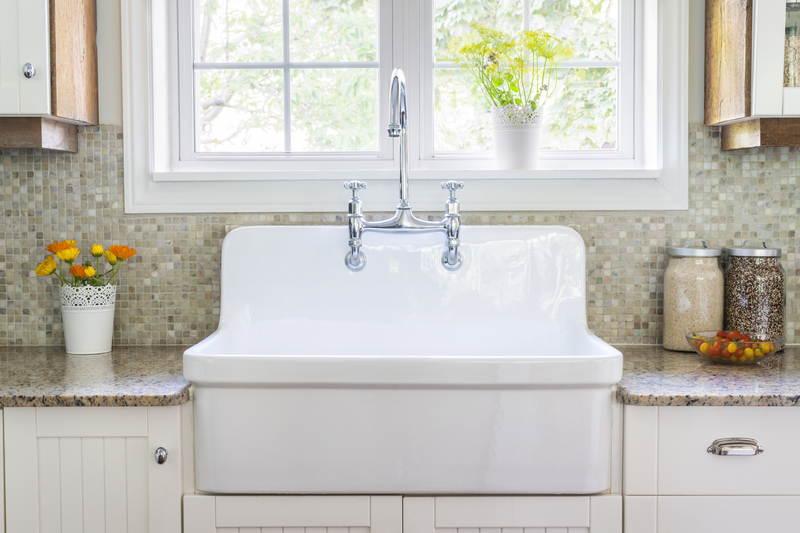Damp Smell Demystified: How to Eliminate It
Posted on 02/06/2025
Damp Smell Demystified: How to Eliminate It
If you have ever walked into a room and been greeted by an unpleasant, musty odor, you know exactly what a damp smell is. This elusive odor is not just an inconvenience; it's a sign of underlying moisture problems in your home or workspace. But what exactly is a damp smell, why does it occur, and, most importantly, how can you get rid of it for good? In this comprehensive guide, we'll demystify the damp smell, explain the sources, health implications, and offer proven steps to eliminate it and prevent its return.

Understanding Damp Smell: What Is It?
A damp smell--often described as musty, moldy, or even earthy--is typically a sign that excess moisture is present in an enclosed space. This odor arises when mold, mildew, or bacteria break down organic matter in moist, poorly ventilated areas. Rather than just being an unpleasant experience, identifying and tackling a damp smell promptly is crucial for maintaining both your property and your health.
Common Places Where Damp Smells Occur
- Basements and Cellars - These areas are often prone to excess humidity and poor ventilation.
- Bathrooms - Frequent water usage, leaks, and condensation make bathrooms a top culprit.
- Kitchens - Leaky pipes, unventilated dishwashers, or improperly dried dish rags can all cause musty odors.
- Laundry Rooms - Wet clothes left sitting, broken washing machines, or ineffective dryers add moisture.
- Wardrobes and Closets - Poor air circulation and storage of damp items contribute to mold growth and odor.
- Attics - Water leaks from roofs or condensation buildup can create prime conditions for musty smells.
What Causes a Damp Smell?
The primary cause of damp smells is moisture. But several factors drive the creation of moisture and subsequent odors within closed spaces:
- Water leaks from pipes, roofs, or walls saturate nearby materials and allow mold and mildew to thrive.
- Poor ventilation traps humidity, creating a humid microclimate perfect for biological growth.
- Condensation forms on cold surfaces, adding unnoticed moisture to hidden corners or within walls.
- Flooding or water ingress--even small, infrequent spills or seepage can lead to ongoing odor problems.
- Wet building materials, such as carpets, gypsum board, and wood, retain water for long periods, creating lingering odors.
- Organic material buildup (like dust, skin cells, pet hair) provides food for bacteria and mold.
The Science Behind The Musty Odor
The signature musty and moldy smell is typically caused by microbial volatile organic compounds (MVOCs). These are chemicals produced by molds as they grow. Some molds and bacteria essentially "eat" organic materials in your home, like wood, paper, or fabric, emitting these pungent, often unhealthy odors as waste products.
Why Eliminating Damp Smell is Essential
Getting rid of a damp odor is more than just a matter of comfort--it's important for your health and the integrity of your home:
- Mold Exposure Risks: Prolonged exposure to mold spores and MVOCs can trigger allergies, asthma attacks, chronic sinusitis, headaches, and other respiratory problems.
- Structural Damage: Excess moisture fosters rot and decay in building materials, leading to costly repairs.
- Reduced Property Value: Homes with a lingering damp or musty odor are less appealing to buyers or renters.
Step-By-Step: How to Eliminate Damp Smell
1. Identify and Eliminate The Source of Moisture
The first critical step to eradicating a damp smell is to find and remove the source of excess moisture.
- Look for visible leaks under sinks, around toilets, in the basement, or near any exposed plumbing.
- Inspect walls, ceilings, and window frames for water stains, bubbling paint, or discoloration.
- Check for condensation on windows, pipes, or other surfaces.
Repairing leaks, sealing cracks, or replacing faulty windows and pipes is essential to halt further moisture entry.
2. Thoroughly Dry Out the Area
Use fans, dehumidifiers, or open windows to speed up the drying process. Focus on areas like:
- Carpets and rugs (which often soak up moisture and retain odors)
- Wooden floors and subfloors
- Drywall and insulation
- Stored fabrics or cardboard boxes
If possible, remove water-logged items for professional drying or dispose of them entirely if mold is visible.
3. Clean All Affected Surfaces
To neutralize odors and kill mold, thoroughly clean walls, floors, furniture, and any damp-smelling fabrics. Use one or more of these solutions:
- White vinegar solution: Mix equal parts vinegar and water. Spray and wipe down hard surfaces.
- Baking soda: Sprinkle on carpets or upholstered furniture, let sit, then vacuum thoroughly.
- Hydrogen peroxide (3%): Safely removes mold and mildew from hard surfaces. Test for colorfastness first.
- Commercial enzyme cleaners: Especially effective on soft furnishings and carpets--break down organic odor sources.
Always wear gloves and a mask when cleaning moldy surfaces to protect yourself from spores and harsh chemicals.
4. Improve Ventilation
Stagnant air traps humidity, so improving air circulation is crucial for stopping damp odors from returning:
- Install or repair extractor fans in bathrooms, kitchens, or laundry rooms.
- Use ceiling or portable fans to keep air moving.
- Open windows daily (when possible) to exchange indoor air for outdoor air.
- Add vents, louvered doors, or air bricks to particularly stuffy rooms like basements or closets.
For naturally humid climates or persistent damp issues, a dehumidifier can make a dramatic difference.
5. Remove and Replace Severely Damaged Materials
Sometimes, building materials like drywall, carpet pads, or insulation are too water-damaged and musty to save. Prolonged exposure to moisture leads to embedded odor and mold that won't completely go away with surface cleaning alone. If you notice black mold, crumbling drywall, or warped wood, it's time for replacement.
6. Neutralize Odor Molecules
After removing the source and cleaning, lingering odors can be tackled with odor-neutralizing products:
- Activated charcoal--Place bags or containers around the room to absorb odors.
- Baking soda--An open box in closets, cupboards, or near problem spots will capture smells.
- Odor absorbers or air purifiers--HEPA and carbon filter purifiers catch both spores and odor molecules from the air.
- Essential oils--Lemon, tea tree, or eucalyptus oils in a diffuser can help freshen the air (once the source is gone).
7. Regular Maintenance to Prevent Return
Ongoing vigilance is key to keeping your home free from the dreaded damp smell:
- Check plumbing and roofs regularly for leaks.
- Run a dehumidifier in basements, bathrooms, or laundry rooms during humid periods.
- Store fabric and cardboard items off the floor and away from external walls.
- Clean and dry spills or wet items immediately.
- Discard old newspapers, magazines, or clothes prone to absorbing odors.
Tips for Eliminating Damp Smell in Specific Areas
How to Get Rid of Damp Smell in Carpets and Rugs
- Deep clean with a wet/dry vacuum after using a vinegar or enzyme-based cleaner.
- Remove and air-dry outside if possible; sunshine kills odor-causing organisms.
- Sprinkle baking soda overnight, then vacuum.
- If odor persists, consider professional cleaning or replacement for wall-to-wall carpeting.
Eliminating Damp Odor in Wardrobes and Clothes
- Wash all affected clothing and linens with baking soda or vinegar added to the cycle.
- Use closet dehumidifiers or moisture-absorbing crystals.
- Avoid overstuffing closets--air flow is essential.
Neutralizing Damp Smell in Cars
- Check for hidden leaks in doors, windows, or the trunk.
- Shampoo and dry carpeted floor mats and seats.
- Run the air conditioning with windows open for 10 minutes.
- Place activated charcoal under seats for continuing odor absorption.
Natural Remedies for Damp and Musty Smells
If you prefer a natural approach to odor elimination, try these eco-friendly solutions:
- White vinegar--neutralizes bacteria and odor (great for wiping down walls or spraying air).
- Lemon juice--a natural disinfectant and fresh scent booster (add to cleaning water).
- Baking soda--absorbs odors when sprinkled on soft surfaces or placed in bowls.
- Charcoal briquettes--place in a pan to absorb persistent odors in rooms or closets.
- Houseplants--certain plants (like peace lilies or English ivy) improve air quality and help control indoor humidity.
When to Call a Professional for Damp Smell
Most damp smells can be resolved with DIY cleaning and better ventilation, but some signs require professional help:
- Pervasive mold (over 1m? or a persistent black or green stain)
- Recurrent flooding, structural water damage, or leaks behind walls
- Health symptoms linked to indoor air quality (allergies, asthma, infections)
Professional mold remediators use advanced detection tools, air scrubbers, and industrial dehumidifiers to thoroughly eliminate even the most stubborn sources of moisture and odor.

Preventing Damp Smell: Homeowner Best Practices
Once your space is clean and fresh-smelling, keep it that way by following these simple tips to prevent damp odors from returning:
- Invest in a home humidity meter; aim for indoor humidity between 30%-50%.
- Check attic and crawl spaces after heavy rains for hidden leaks.
- Regularly clean out drain pans under appliances and air conditioners.
- Ensure air bricks and vents are unobstructed.
- Don't ignore small leaks--fix them immediately.
- Keep gutters and downspouts clear to prevent water backup affecting foundations.
Conclusion: Banish Damp Smell for Good
Unpleasant damp odors do not have to be a permanent fixture in your living space. Identifying the source of moisture, investing in thorough cleaning, improving ventilation, and implementing proactive maintenance will help you eliminate damp smells quickly and for good. Remember, a clean and fresh-smelling home is not just more inviting--it's healthier and lasts longer.
Take control today by following the proven strategies above and enjoy a fresher, healthier environment free from musty, damp odors!


